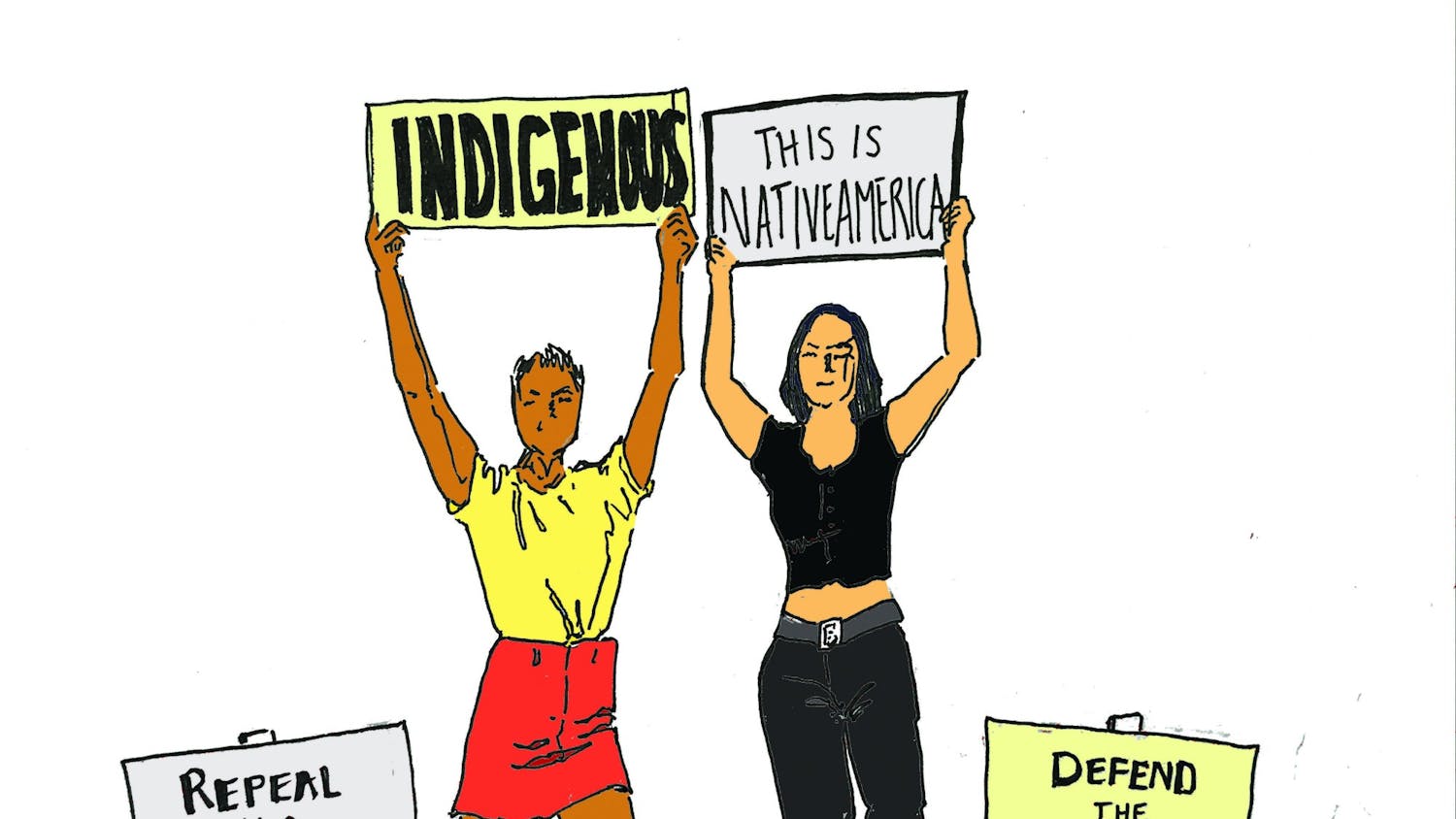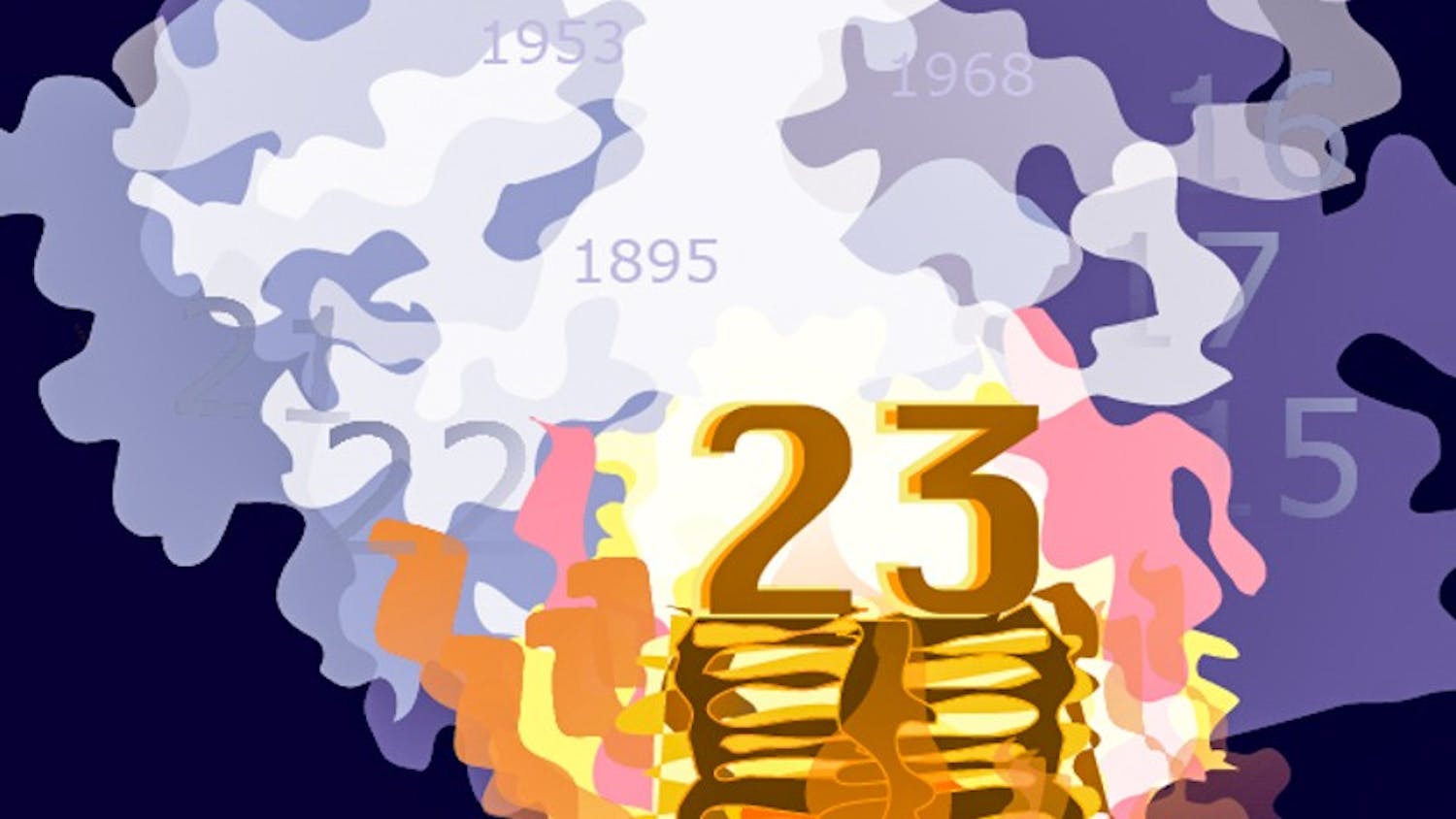Nearly 50 years ago, a group of Native American students approached the steps of Parkhurst Hall with a clear goal in mind — to end the use of the Dartmouth “Indian” as the College’s symbol and mascot.
“We, the Native Americans at Dartmouth, declare that various traditions and symbols used by the Dartmouth Community are based upon insensitivity to the culture of Native American Peoples,” they wrote in their statement to the College administration.
Dartmouth is an institution heavily steeped in history and tradition. As Homecoming season rolls around once again, the College will soon rekindle its commitment to “the old traditions” of the Alma Mater through its annual bonfire celebration, football game and alumni reunions. However, at a time when school spirit peaks and tradition-driven sentimentality tends to resurface, it is just as important to recognize the aspects of Dartmouth’s history that often go unacknowledged or undiscussed.
Dartmouth’s relationship with Native American peoples marks a particularly troubled facet of the College’s nearly 250-year-old history.
According to College archivist Peter Carini, the history of Dartmouth’s iconography — the symbols and visuals found around campus — reveals a pattern of relegating Native Americans to the subjects of myth within College tradition.
The strains between Dartmouth and Native Americans predate the founding of the College itself, Carini noted. In the College’s charter, Eleazar Wheelock wrote that his school would fulfill the purpose of the “education and instruction of youth of the Indian tribes.” He famously sent one of his brightest students, a Mohegan Indian named Samson Occom, to England in order to preach and raise funds for the establishment of an “Indian charity school.” While Occom was abroad, however, Wheelock decided to repurpose his school as a college, which would more broadly educate “English youth and any others.” Wheelock’s change of heart created a rift between himself and Occom, who found his family destitute upon his return to America.
The first Native American did not graduate from Dartmouth until 1788, nearly 20 years after the College’s founding, according to Carini.
Carini noted that while very few Native Americans attended or graduated from the College for much of its early history, Dartmouth’s student body found itself swept up in the lore of the College, and the constructed image of the Native American as a “sort of noble savage” became popular on campus by the late 1800s. One of the most prominent depictions of Native Americans on campus at the time can be traced back to “Indian head canes” — walking canes carried by upperclassmen that featured a wooden caricature of a Native American’s head at the top.
“The College became known for being a school for Native Americans, which it never had been in that sense or at least not until very recently,” Carini said.
By the 1920s, Boston sportswriters had adopted the Dartmouth “Indians” as the name for Dartmouth’s football team. While Dartmouth never officially adopted the Indian as its symbol, its wide usage and popularity lent it legitimacy as the main icon for the College until the 1960s.
Within this period, portrayals of Native Americans on Dartmouth’s campus abounded, manifesting in everything from College merchandise to cheerleader costumes to advertisements in local publications. Images in the College’s archives at the Rauner Special Collections illustrate the extent to which the symbol of the Indian dominated campus culture. One photograph depicts a football team from the 1940s wearing “Indian heads” — red rubber masks made to resemble a caricature of a Native American. An advertisement in the Dartmouth Alumni Magazine, drawn by Dr. Seuss for an alumni fundraiser, features a cartoon of a Native American and a drawing of the Cat in the Hat with broken feathers protruding from his headpiece.
Notably, the appearance of the Indian symbol on football uniforms did not occur until 1965, according to a 1972 article in The Dartmouth by former College president and then-history professor James Wright.
By 1970, former College president John G. Kemeny’s initiative to re-center Dartmouth’s mission upon its original purpose of educating Native Americans led to an influx of students from indigenous backgrounds. Upon arriving at the school, many Native American students found the characterization of the Dartmouth “Indian” harmful and disturbing. A group of these students, assembled by Howard Bad Hand ’73, Duane Bird Bear ’71 and Rick Buckanaga ’72, wrote a policy statement to the administration calling for the immediate end of the use of the “Indian” as a mascot, the discontinuation of college merchandising and images in publications that depicted the Indian and the removal of the controversial murals in the Hovey Grill.
“We Native Americans at Dartmouth unequivocally declare that the ‘Indian symbol’ is a mythical creation of non-Indian culture and in no manner reflects the basic philosophies of Native American peoples,” the students wrote. “… It is said that these “Indian” symbols represent ‘pride’ and ‘respect,’ yet pride and respect do not lie in caricatures of people, but in self-awareness of fallibility.”
The College Board of Trustees launched an investigation into the matter, which found the use of the Indian symbol “in any form” to be “inconsistent with the present institutional and academic objectives of the College in advancing Native American education.” The board urged the College towards the “voluntary discontinuance” of the symbol, and the Indian was subsequently de-recognized as the College’s mascot and removed from athletic uniforms.
However, the decision was met with a substantial share of vitriol from many alumni and students alike, who perceived the symbol’s rejection as an affront to tradition.
“The original revocation was ill-considered and engineered by a vociferous handful who did not properly represent the group they claimed to,” wrote Gil Hahn ’75 in a 1974 issue of Dartmouth Alumni Magazine.
In contrast, Edward Nickerson ’49 sarcastically wrote to the Magazine, “Dartmouth, we are told in tones of self-pity, is being pushed around by minorities. All because some groups in the College showed some sensitivity to the feelings of the majority of Native Americans on campus, when someone actually asked them how they felt. Don’t those redskins know they exist for the purposes of myth, not reality?”
The Dartmouth Review also championed efforts to revive the Indian mascot, selling shirts featuring the Indian symbol and polling Native Americans from tribes across the country in an attempt to prove that the Dartmouth Indian was inoffensive.
Resurgences of support for the Indian symbol have periodically flared up in the decades following the board’s decision. In 1983, students in the stands of a football game unfurled a banner depicting a caricature of a Native American head with the words “Dartmouth Indian” scrawled across it. More recently, in 2006, the men’s crew team garnered controversy for hosting a formal in which guests dressed up as stereotypical Native Americans.
However, Native American studies professor N. Bruce Duthu ’80 points to the progress Dartmouth has made in spite of these setbacks.
“With a Native alumni body approaching 1200, a nationally respected academic program in Native American Studies and renewed leadership in the Native American program … the College has certainly strengthened its case for sustained commitment to the Native community in the last several decades,” Duthu said.
Duthu recently served as a co-chair on a committee to determine the fate of Dartmouth’s Hovey murals — a series of paintings in the basement of the Class of 1953 Commons that have long served as point of contention at the College. The murals, painted by Walter Beach Humphrey, Class of 1914, in the late 1930s, prominently feature depictions of naked women and inebriated Native Americans.
In late September of this year, the committee arrived at the decision to move the murals to an off-campus facility.
Ishaan Jajodia ’20, a writer for The Dartmouth Review, said he disagreed with the decision to move the murals.
“[The Hovey murals] are a part of our history, and if you don’t engage with it, you’re effectively erasing it ... Don’t celebrate them, but contextualize them, keep them open and let people judge for themselves,” he said.
Duthu said that keeping the murals in the basement of ’53 Commons can be seen as an implied endorsement of the images in the murals.
“In their current location, the murals accumulated undeserved prominence and power — a position that was often equated with institutional approval or endorsement of the visual images depicting Native people,” Duthu said. “Removing them from the major dining facility on campus serves to make that space more accessible to all students.”
Today, depictions of Native Americans on Dartmouth’s campus exist to a far lesser degree than they did 50 years ago. At the same time, the Dartmouth seal still prominently features two Native American figures. Likewise, the weathervane atop Baker-Berry Library depicts Wheelock sitting on a stump, with a Native American student sitting on the ground below him.
As Duthu points out, even the “uglier” aspects of Dartmouth’s history are inextricably bound to the identity of the College. The recent re-ignition of debates over the Hovey murals, for example, points to a larger narrative in which the College continually attempts to acknowledge its past transgressions against Native Americans and re-evaluate its obligations as an institution. However, it is ultimately up to each student to decide how Dartmouth’s traditions — including its symbols and visuals — should manifest themselves on campus in the future.
“At its core, history is about remembering — or more particularly, what we choose to remember,” Duthu said. “Some of us live with daily reminders of how the past still haunts the present and therefore need fewer, if any, visual reminders about our past sorrowful treatment of each other. For others, those reminders — visual and otherwise — are a necessary element in the pursuit of a liberal and morally grounded education.”
Ishaan Jajodia is a former member of The Dartmouth staff.
Elizabeth Janowski '21 is the news executive editor of the 177th directorate. Hailing from Brookfield, Wisconsin, she is pursuing a double major in history and film and media studies.



